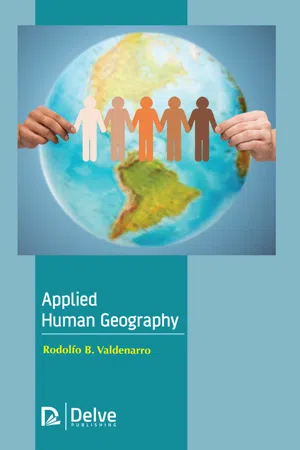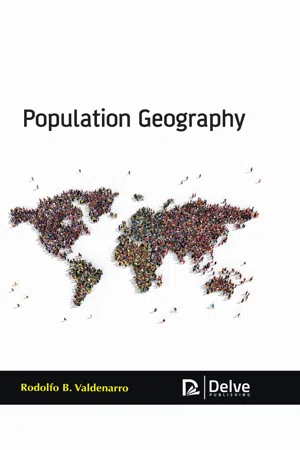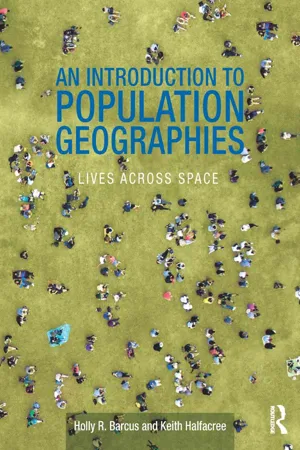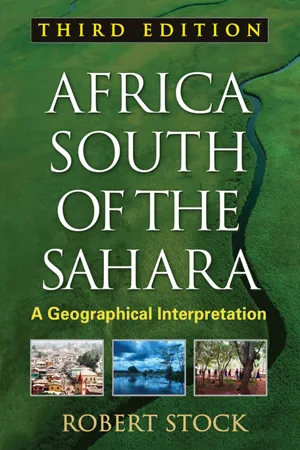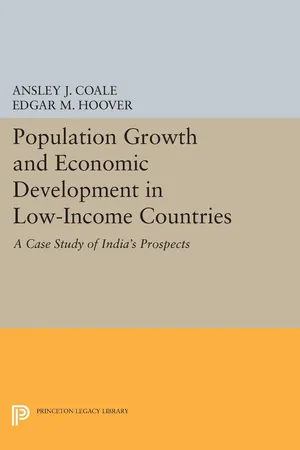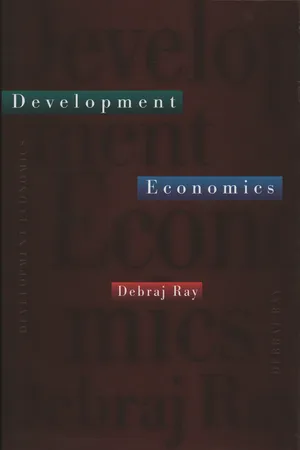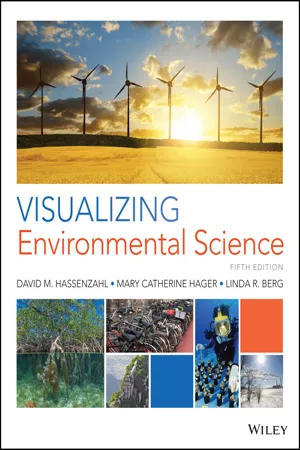Geography
Population and Development
Population and development refer to the relationship between the size, distribution, and characteristics of a population and the social, economic, and environmental changes that occur as a result. This includes studying how population growth, urbanization, and migration impact a region's development, including its infrastructure, resources, and quality of life. Understanding this relationship is crucial for planning and policy-making.
Written by Perlego with AI-assistance
Related key terms
1 of 5
12 Key excerpts on "Population and Development"
- eBook - PDF
- R. Knowles, J. Wareing(Authors)
- 2014(Publication Date)
- Made Simple(Publisher)
PART TWO : POPULATION GEOGRAPHY CHAPTER FIVE POPULATION DISTRIBUTION Until quite recently the systematic study of population had been largely neglected by geographers, in contrast with other fields of human geography such as agriculture, industry and settlement which have a long-established tradition of systematic analysis. However, in recent years there has been a growing awareness of the importance of population studies within the broad framework of human geography. Population geography has rapidly advanced from a peripheral position within the discipline to the stage where it has been claimed that 'numbers, densities and qualities of the population provide an essential background for all geography. Population is the point of reference from which all the other elements are observed and from which they all, singly and collectively, derive significance and meaning. It is population which furnishes the focus.* (G. T. Trewartha) Population geography is concerned with the study of demographic processes and their consequences in an environmental context. It may thus be distin-guished from demography by its emphasis on the spatial variations in the growth, movement and composition of populations, and its concern with the social and economic implications of these variations. The development of the subject has been severely limited by a lack of demographic data for many parts of the world, but, like other branches of geography, it is concerned with description, analysis and explanation, although a large part of the work to date has been concerned with population mapping and descriptive studies, simply in order to establish the data base which must precede analysis. Sources of Population Data One of the most difficult problems facing the population geographer is the varied quality of population data available for different countries and regions of the world. - eBook - PDF
- Rodolfo B. Valdenarro(Author)
- 2019(Publication Date)
- Delve Publishing(Publisher)
Population Geographies 6 CONTENTS 6.1. Introduction .................................................................................... 116 6.2. Development of Population Geography .......................................... 118 6.3. Different Variations of Population Geography ................................. 122 6.4. The Importance of Density And Composition .................................. 124 6.5. Recent Developments In Population Geography ............................. 126 6.6. Scope of Population Geography ...................................................... 128 6.7. Important Aspects of Population Geography ................................... 129 6.8. Contemporary Population Geography ............................................. 132 Applied Human Geography 116 Population geographies have explained the concepts that had led to the improper population division all over the world. The field of Population Geography primarily lays its focus on the researches and studies of the allocation, dispersal and density of the population in any specific area all over the world. In addition to the allocation and density of the people all over the world, the discipline of population geography aims on observing the factors that affect the variations in that have been observed in the size of the population all over the world, fluctuations and attributes such as the structures, human activity, human migration and a number of activities that have been registered in the modern times. Population geography studies the aspects of the geography that has been linked with the human beings. Population geography helps the experts in understanding how the geography has changed with the sudden increase on the population all over the world and how these changes will return back to the human beings. - eBook - PDF
- Rodolfo B. Valdenarro(Author)
- 2020(Publication Date)
- Delve Publishing(Publisher)
Population and Development 8 CONTENTS 8.1. Introduction .................................................................................... 194 8.2. Understanding Population Growth Rates And Development ........... 194 8.3. Population And Sustainable Development ...................................... 198 8.4. United Nations (UN) International Conferences 1990’S .................. 201 8.5. Strategies Developed To Address The Environmental And Development Problems Caused by Population Issues ................... 205 8.6. Environmental Impacts of Population .............................................. 207 8.7. The Rights of People Today .............................................................. 210 Population Geography 194 8.1. INTRODUCTION Globally, the rate of people being added amongst the existing population is increasing every year. The issue of population is not a mere problem on increased numbers. Instead, it is an issue of human welfare and it affects development. Past studies have concluded that when population growth is rapid there are some serious repercussions for the well-being of humanity globally. The term development has had many definitions. In this chapter, we will refer to it as the improvement of the level of living of people’s life, which is their health, incomes, education, and the overall well-being. It also entails their respect, dignity, self-esteem, and freedom of choice. Population growth rate has been found to have a relationship with development for example in Africa this is a major problem but not the only factor. There are other many countries globally and not just African countries which have also witnessed the impact that population growth rate has on the development aspects. There are major issues that affect Population and Development such as the level of living, increased in labor force, unemployment, poverty alleviation, improved education, and health, freedom of choice, etc. - eBook - PDF
- Gregory Hooks(Author)
- 2016(Publication Date)
- University of California Press(Publisher)
The concept of development has been defined and redefined many times in the past. At the most basic level, it refers to the Western idea of progress and growth stemming from the philosophy and scientific advances of the Enlightenment, with globalization being its latest operational version inducing much criticism. However, no matter how one defines development, it has a strong foundation in aggregate human conditions P O P U L A T I O N A N D D E V E L O P M E N T • 65 and a mutual interrelation with population dynamics. Development creates the intel-lectual framework for population studies, and demography provides pragmatic consid-erations for development theory. It is unlikely that scholars will ever agree on Population and Development narratives and actions as much as they did under the modernization paradigm, but no matter how context-dependent the causal mechanisms between the two may be, Population and Development are inseparable. And, while working on the numerous global and local challenges in that nexus, demographers and development scholars alike are responsible for keeping the discourse focused on all three of the broad issues: economic prosperity, environmental impact, and social equality. REFERENCES Allen, Garland. 1989 . “Eugenics and American Social History, 1880–1950 .” Genome 31 : 885–89 . Bauer, Peter. 1972 . Dissent on Development. Cambridge, Mass.: Harvard University Press. Beale, Calvin. 1975 . The Revival of Population Growth in Non-Metropolitan America. USDA ERS-605 . Washington, D.C.: U.S. Department of Agriculture. Becker, Gary. 1960 . “An Economic Analysis of Fertility.” In Demographic and Economic Change in Developed Countries, edited by the National Bureau for Economic Research, 209–40 . New York: Columbia University Press. . 1981 . A Treatise of the Family. Cambridge, Mass.: Harvard University Press. Birdsall, Nancy, Allen Kelley, and Steven Sinding, eds. - eBook - ePub
- Louise Lassonde(Author)
- 2014(Publication Date)
- Routledge(Publisher)
—————————————— Chapter 3 Population and DevelopmentDevelopment, the last word in the title of the Cairo Conference, was supposed to be the cornerstone of that gathering. This was to be achieved through renewed discussion of the relationships between demographic change and development factors within the framework of the concept of sustainable development, adopted by the international community in Rio. In reality, however, development remained the poor relation, and the few development-related measures in the Programme of Action are those for harmonizing Population and Development trends. They are summarized below.——————————————Population and Development: Programme of Action
Rights and Principles
The right to development is a universal and inalienable right and an integral part of fundamental human rights. It must be fulfilled so as to equitably meet the population, development and environment needs of present and future generations. While development facilitates the enjoyment of all human rights, the lack of development may not be invoked to justify the abridgment of internationally recognized human rights.Individuals have the right to a healthy and productive life in harmony with nature, and to an adequate standard of living for themselves and their families, including food, clothing, housing and drinking water. Human beings are at the centre of concerns for sustainable development, and they are the most important and valuable resource of any nation. Demographic goals and policies form part of cultural, economic and social development, and are directed principally at improving the quality of life of all people. Even the difference of a single decade in the transition to stabilization levels of fertility can have a considerable positive impact on quality of life.All countries should recognize their common but differentiated responsibilities. Sustainable development requires that the interrelationships between population, resources, the environment and development should be fully recognized, properly managed and brought into harmonious, dynamic balance. - eBook - PDF
- Christopher Boone, Ali Modarres(Authors)
- 2009(Publication Date)
- Temple University Press(Publisher)
2 Population, Urbanization, and Environment P OPULATION G ROWTH I T IS DIFFICULT to discuss population without referring to three interrelated dimensions: magnitude, space, and time. Anyone engaged in population policy matters knows that one cannot make a convincing argument about population growth without some reference to the spa-tial and temporal specificity of growth, which highlights the differen-tial nature of population impacts from one place to another. Beyond this methodological specificity, however, population discussions must also focus on the sociopolitical, cultural, historical, and economic contexts within which specific demographic patterns occur. From John Graunt’s “life table” (1662) 1 of London to the most recent publications of the United Nations, demographic publications have touched upon the com-plexity of population through this multidimensional approach. Discus-sions of population “catastrophes” must likewise take into account time, space, politics, economy, and culture. One need only read Malthus’s nineteenth-century treatise on population to appreciate the degree to which the sociopolitical and cultural values of a community determine its perception of population issues and of how they can best be man-aged. The looming population problems that confront us at various geo-graphic scales are complex, and finding solutions is no easy task. Given that our focus here is on cities, population issues will be exam-ined within this context. Not only have cities acted throughout history as geographic nodes around which people have gathered in large num-bers, but in the last few centuries they have also gradually become the major areas of human occupation. Urbanization rates in a number of countries exceeded 50 percent in the twentieth century, suggesting that people have looked to cities as places of work and leisure at a faster pace than ever before in human history. Cities have thus become arenas in which the dynamics of population are played out. - eBook - ePub
An Introduction to Population Geographies
Lives Across Space
- Holly R. Barcus, Keith Halfacree(Authors)
- 2017(Publication Date)
- Routledge(Publisher)
There is a clear prima facie case for the discipline of Demography : “the scientific study of the size, composition, and distribution of human populations and their changes resulting from fertility, mortality, and migration” (Poston and Bouvier 2010: 3). Births, deaths and human migrations between locations across the globe certainly require measurement, presentation and discussion, and future trends predicted. But whilst Demography also involves itself with the causes of the patterns, trends and magnitudes it identifies—“the factors that affect these components” (Poston and Bouvier 2010: 3)—a more dedicated emphasis on their contextualized spatial expression has become the focus of Population Geography. 1.2.2 … across real places Population Geography can be defined initially as the study of “the geographical organization of population and how and why this matters to society” (Bailey 2005: 1). An immediate illustration of how such a spatial lens is both significant and important comes, once again, via some simple demographic facts about the state of the world today (developed more fully in Chapter 3). Consider infant mortality rates (10.3.1) in a small selection of countries in Asia and Europe, shown in Table 1.1. First, even across these ten countries there is a considerable range of values. This is true even within the same continent, such as the contrast between Romania and Norway in Europe. Second, although there is a general trend towards declining infant mortality, countries such as Mongolia and India retain extremely high rates. Furthermore, many countries affected by civil strife, such as Afghanistan, Congo or Iraq, are understandably unable to provide data. Thus, Table 1.1 is biased in favor of countries experiencing relative political stability - No longer available |Learn more
- United Nations Economic and Social Commission for Asia and the Pacific(Author)
- 1993(Publication Date)
- United Nations Publications(Publisher)
VI. POPULATION DYNAMICS: IMPLICATIONS FOR DEVELOPMENT T here is a two-way interaction between population and deve-lopment, the extent and complexity of which may vary in time and context. The size and composition of the existing population and its growth over time have an impact on development. Develop-ment itself also affects various demographic characteristics, includ-ing population growth rate. At the conceptual level, there is an agreement on the two-way interaction, but there are differences of views on their magnitude and the direction which tend to be highly context-specific.1 The task of measurement and identification is additionally complicated by the fact that interaction between Population and Development is mediated through a variety of channels, such as health, education, and labour force participation. While recognizing these com-plexities, the present work primarily examines the emerging population dynamics in the region and its implications for selected deve-lopment issues that countries will have to confront. The chapter concludes with a discussion of the major highlights of the evolution of population policies in the region. 1 United Nations Population Fund, “Population and Development strategies: review of the past and future prospects”, presented at Round Table on Population and Development Strategies, Bangkok, 17-19 November 1993. THE DYNAMICS OF CHANGE Growth trends During the last few decades, the world as a whole experienced what is often termed as a “popu-lation explosion”. Much of this explosive growth has occurred in the poorer parts of the world. A rapid decline in mortality and slower decline in fertility rates have been responsible for rapid population growth in the develop-ing world during the last three decades. The world population, after remaining static for centuries, started growing with the onset of the industrial revolution in Europe. By 1825, world population is esti-mated to have reached 1 billion. - eBook - PDF
Africa South of the Sahara
A Geographical Interpretation
- Robert Stock(Author)
- 2012(Publication Date)
- The Guilford Press(Publisher)
225 DYNAMICS OF POPULATION Geographers have long recognized the importance of studying the dynamics of population, which encompass distribution, growth, and mobility. Where people live and where populations are growing, whether through natural increase or migration, often reflects the relative health—ecological, economic, social, and political—of places. At the same time, rapid population change may both reflect and contribute to the destabilization of what previously appeared to be relatively stable situations. Many of the characteristics of Africa’s present population distribution and patterns of change reflect processes that have operated for decades, centuries, or even millennia. For example, population distribution reflects in certain ways not only postindependence migrations, like those from the countryside to the city, but also the colonial reshaping of Africa’s political and economic map; it even reflects major historical migrations. Chapter 13 looks at the uneven distribution of population. Some of the explanations that have been used to account for population distributions, including both environmental and historical factors, are noted. The uneven distribution of population may have a variety of effects, ranging from environmental degradation in vulnerable environments to the limited prospects for diversified development that exist for many countries with small national populations. In Chapter 14, the focus turns to the rapid growth of African populations, and the implications of this growth for the continent’s future. With a growth rate of 2.5% per year, population is expanding faster in Africa than anywhere else in the world. Linkages are often made between population growth and various problems, whether damage to ecosystems or food shortages. However, although few would deny the serious implications of rapid population growth, the assertion that such growth is the primary cause of these problems remains open for debate. - eBook - PDF
- Ansley Johnson Coale, Edgar M. Hoover(Authors)
- 2015(Publication Date)
- Princeton University Press(Publisher)
PART ONE RELATIONS BETWEEN POPULATION AND ECONOMIC DEVELOPMENT C H A P T E R I I φφφφφ&ϊ><ΐ>φφ <><ι ><ί><ΐ><><£><><ϊ >4>4>4><ι ><ϊ <ι><ι>φφ<ε><£><><><ΐ>φ<^ THE EFFECTS OF ECONOMIC DEVELOPMENT ON POPULATION GROWTH IN SURVEYING RELATIONS between two complex sets of changes it is natural to begin with the influence of one set on the other, and then to consider influences operating in the opposite direction. Our introductory survey of demographic and economic changes will follow this procedure, beginning in this chapter with a description of how economic development can influence population growth. This influence must operate through one or more of the three de- terminants of population growth—namely, births, deaths, and migration. Migration as an important cause of economic growth will not be discussed, because in general the substantial international barriers to large-scale migration make it a very uncertain element in the future growth of low-income areas, and in particular inter- national migration seems unlikely to have an important effect on the future growth of the Indian population. The classical economic theory of population growth (primarily associated with Malthus) held that any rise in incomes (particularly among the poorer classes) tended to increase birth rates and (with more certainty and force) to decrease death rates. The course of events since Malthus' time, however, has led to the gradual evolution of a theory that postulates a more complicated se- quence of birth and death rates as typically associated with economic development. It is sometimes termed the theory of the "demographic transition." According to this theory an agrarian peasant economy (characterized by a high degree of self-sufficiency within each com- munity and even each family, by relatively slow change in technique, and by the relatively unimportant role of market exchange) typi- cally has high average death rates. - eBook - ePub
- Debraj Ray(Author)
- 1998(Publication Date)
- Princeton University Press(Publisher)
Chapter 9Population Growth andEconomic Development
9.1. Introduction
The world is populated today as it has never been before. Although rates of population growth have fallen and will continue to fall, we currently add about a million people every four days to the world population, net of deaths. According to projections carried out by the United Nations, annual additions to the population are likely to remain close to the ninety million mark until the year 2015.It took 123 years for world population to increase from one billion (1804) to two billion (1927). The next billion took 33 years. The following two billions took 14 years and 13 years, respectively. The next billion is expected to take only 11 years and will be achieved by 1998, at which time we will arrive at the staggering figure of six billion. Such is the power of exponential growth.However, more than just exponential growth is hidden in this story. Population growth through the millennia has not proceeded at an even exponential pace. The growth rate of population has itself increased, and the trend has reversed only in the last few years. Part of our purpose in this chapter is to tell this complex and interesting story.Yet a description of trends is not our only purpose, because this is a book about economics, not demographic statistics. We are interested primarily in how the process of development has spurred (or retarded) population growth and, more important, we want to know how population growth in turn affects economic development. As with the evolution of now-familiar variables such as per capita income and economic inequality, Population and Development are intertwined, and we seek to understand both strands of the relationship.The question of how population growth affects development runs into an immediate difficulty. How do we value the lives of the people yet unborn? Is a small population living in luxury better off than a large population living under moderate circumstances? How do we compare the fact that a larger number of people are around to enjoy the “moderate circumstances” with the alternative in which luxuries are available to a smaller number, simply because the births of the rest were somehow prevented? - eBook - PDF
- David M. Hassenzahl, Mary Catherine Hager, Linda R. Berg(Authors)
- 2016(Publication Date)
- Wiley(Publisher)
168 CHAPTER 7 Human Population Change and the Environment 1. Describe the demographic transition. 2. Explain how highly developed and developing countries differ in population characteristics such as infant mortality rate, total fertility rate, replacement-level fertility, and age structure. W orld population figures illustrate overall trends but don’t describe other important aspects of the human population story, such as population differences from country to country (Table 7.1). Demographics provides informa- tion on the populations of various countries. Recall from Chapter 1 that countries are classified into two main groups—highly developed and developing—based on population growth rates, degree of industrialization, and relative prosperity. Highly developed countries such as the United States, Canada, France, Germany, Sweden, Aus- tralia, and Japan have the lowest birth rates in the world. Indeed, some countries, such as Germany, have birth rates just below those needed to sustain their populations and are declining slightly in numbers. Highly developed countries also have low infant mor- tality rates (Figure 7.12a). The infant mortality rate of the United States was 6.0 in 2015, compared with a world rate of 37. Highly developed countries have lon- ger life expectancies (79 years in the United States versus 71 years worldwide). Per person GNI PPP is a country’s gross national income (GNI) in purchasing power parity (PPP) divided by its population. It indicates the amount of goods and services an average citizen of that particular country could buy in the United States. There is a high average per person GNI that a massive wave of human suffering and death will occur. This view doesn’t mean we will go extinct as a species, but it projects severe hardship for many people. Some experts think the human population has al- ready exceeded the carrying capacity of the environ- ment, a potentially dangerous situation that threatens our long-term survival as a species.
Index pages curate the most relevant extracts from our library of academic textbooks. They’ve been created using an in-house natural language model (NLM), each adding context and meaning to key research topics.

